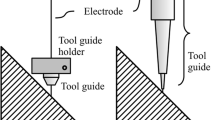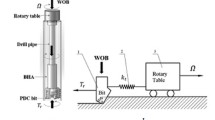Abstract
The hot-dip galvanizing pot in a certain steel plant often experiences severe vibrations. In order to investigate the cause of the vibrations in the hot-dip galvanizing line and further clarify the vibration characteristics of the sinking roller system in the high-temperature zinc liquid, this study first used SolidWorks to establish a three-dimensional model of the sinking roller system in the steel plant and then used Ansys Workbench software to perform modal analysis on the hot-dip galvanizing sinking roller system. Considering the complex flow field and loading conditions inside the zinc pot, this article analyzes the vibration characteristics of the sinking roller system under four main external factors, namely, dry mode, wet mode, prestress mode, and thermal stress mode, in a zinc pot, and the natural frequency changes of the sinking roller system under different density fluids, different loading conditions, and different temperatures were analyzed according to the actual working conditions. The calculation results showed that the natural frequency of the sinking roller device significantly decreased, and the order of mode shapes changed when considering the additional mass of the high-temperature zinc liquid. The tension generated by the strip steel had little effect on the natural frequency of the sinking roller device. The thermal stress generated inside the sinking roller system at high temperatures slightly reduced the natural frequency of the sinking roller device in the high-frequency region, but compared to the decrease caused by the inertia effect of the liquid, it was much smaller. The main mode shapes under the action of prestress and thermal stress were almost unchanged compared to the dry mode; in some mode shapes, excessive deformation of the sliding bearings at both ends of the sinking roller system causes roller displacement. This study theoretically analyzed the vibration characteristics of the sinking roller system, compared the influence of the main external loads in the zinc pot on the vibration characteristics of the sinking roller system, and analyzed the possible reasons for the failure of the sliding bearing of the sinking roller system under certain mode shapes, providing a reference for subsequent vibration reduction and optimization design of the sinking roller system.















Similar content being viewed by others
References
L. Zhang, J. Li, L. Zuo, Development of a new continuous hot-dip galvanizing unit for strip steel. J. Iron Steel Res. 17(4), 9–13 (2005)
J.P. Li et al., Research on vibration control method of steel strip for a continuous hot-dip galvanizing line. Isij Int. 52, 1072–1079 (2012)
C. Gao et al., An analysis on strip vibration coupled with torsional vibration of main drive system of rolling mill. J. Vibroeng. 19, 5679–5690 (2017)
J.H. Shim, S.H. Chung, Y.W. Cho, Prediction of aluminium concentration in molten zinc pot of continuous hot dip galvanising line. Ironmak. Steelmak. 29(6), 454–458 (2002)
P. Li, H. Chen, Vibration analysis of steel strip in continuous hot-dip galvanizing process. J. Appl. Math. Phys. 1, 31–36 (2013)
C.H. Kim, N.C. Perkins, C.W. Lee, Parametric resonance of plates in a sheet metal coating process. J. Sound Vib. 268(4), 679–697 (2003)
Y. Wang, F. Xu, Y. Li et al., Dynamic modeling and coupled vibration study of strip-roll-flexible support hybrid system. J. Vib. Eng. 26(04), 599–607 (2013)
Z. Lu, B. Xiao, W. Li, P. Xu, Dynamic modeling and stability analysis of submerged rolls in hot-dip galvanizing lines. Noise Vib. Control. 36(03), 52–56 (2016)
G. Romero-Galván et al., Robust stability analysis of the hot-dip galvanising control system. Int. J. Autom. Control. 1, 220–232 (2007)
F. Xu, Y. Li, L.L. Li et al., Parametric vibration analysis of strip steel and its supporting system. Mech. Res. Appl. 26(03), 27–30+34 (2013)
X. Wang, H. An, H. Li et al., Experimental study on additional mass and additional damping of sunken roller model in fluid medium. J. Mech. Eng. 56(10), 235–243 (2020)
J. Zhang, H. Guo, R. Liu et al., Modelling and analysis of nonlinear dynamics of spatially hinged extensible truss structures. J. Xi’an Jiaotong Univ. 47(11), 113–119, 126 (2013)
X.F. Cai et al., Production process and technology development of hot-dip galvanizing. Appl. Mech. Mater. 488–489, 61–65 (2014)
D.L. Shalaevskii, Correct calculation of actual tension of steel strip upon continuous cold rolling. Steel Transl. 52, 970–973 (2022)
S. Hui et al., One-third sub-harmonic resonance analysis for the up-going strip emerging from the zinc pot. Key Eng. Mater. 693, 1247–1254 (2016)
X.T. Wang, J.Y. Zhang, Y.G. Du, High temperature mechanical properties of 00Cr17Ni14Mo2 stainless steel. J. Build. Mater. 18(05), 767–772 (2015)
A.K. Singh et al., Strength analysis and optimization methods for four cylinder engine crankshaft based on CATIA and ANSYS. Appl. Mech. Mater. 592–594(2014), 1789–1793 (2014)
J. Wan, X. Wang, W. Li et al., Modal analysis of a turbine expander rotor system supported by electromagnetic bearings. J. Shanghai Jiaotong Univ. 46(19), 86–91 (2010)
Y. Xiang et al., Wet modal analysis of a deep-sea autonomous underwater vehicle. Adv. Mater. Res. 546–547, 171–175 (2012)
Y. Jia, J. Wang, J. Han, Analysis of factors affecting the intrinsic frequency of prestressed simply supported steel box girders. Eng. Mech. 26(S1), 37–40 (2009)
Z. Zeyu et al., Modal analysis of the torque converter in different prestress. High Technol. Lett. 26, 61–67 (2020)
S. Bhardawaj et al., Analysis of frontal car crash characteristics using ANSYS. Mater. Today Proc. 25, 898–902 (2020)
J. Jang, A.W. Smyth, Data-driven models for temperature distribution effects on natural frequencies and thermal prestress modeling. Struct. Control. Health Monit. 27(2), e2489 (2020)
M. Sun et al., Study on the influence of vibration parameters in the twin-roll strip vibration cast-rolling process. Int. J. Adv. Manuf. Technol. 108, 3141–3157 (2020)
H. Huang, X. Wang, Y. Li et al., Study on the factors affecting the vibration intrinsic characteristics of hot-dip galvanizing immersed roll device. Mech. Sci. Technol. 35(02), 187–191 (2016)
M. Yang, H. Wang, Y. Duan et al., Wet modal analysis of liquid storage vessel based on acoustic-solid coupling algorithm. Sichuan J. Mil. Eng. 36(05), 152–154 (2015)
A. Zippo, G. Iarriccio, F. Pellicano, T. Shmatko, Vibrations of plates with complex shape: experimental modal analysis. Finite Elem. Method R-Funct. Method Shock Vib. (2020). https://doi.org/10.1155/2020/8882867
X. Yao, W. Li, Z. Zhou et al., Analysis on dynamic characteristics of track with floating fasteners considering loading of flexible wheelsets. J. Vib. Shock. 42(24), 42–50 (2023)
K.V.S.R. Prasad, V. Singh, Numerical investigation and experimental modal analysis validation to mitigate vibration of induction machine caused due to electrical and mechanical faults. J. Electr. Eng. Technol. 17(4), 2259–2273 (2022)
Acknowledgments
Thanks for the funding of Research and development of key technologies for improving the stability of the sinking roller system of hot-dip galvanized line (RH2200001473).
Author information
Authors and Affiliations
Corresponding author
Additional information
Publisher's Note
Springer Nature remains neutral with regard to jurisdictional claims in published maps and institutional affiliations.
Rights and permissions
Springer Nature or its licensor (e.g. a society or other partner) holds exclusive rights to this article under a publishing agreement with the author(s) or other rightsholder(s); author self-archiving of the accepted manuscript version of this article is solely governed by the terms of such publishing agreement and applicable law.
About this article
Cite this article
Rao, S., Zhang, J., Wang, H. et al. Analysis of Vibration Characteristics and Failure Behavior of Hot-Dip Galvanizing Immersion Roller System in High-Temperature Zinc Pot. J Fail. Anal. and Preven. (2024). https://doi.org/10.1007/s11668-024-01906-w
Received:
Revised:
Accepted:
Published:
DOI: https://doi.org/10.1007/s11668-024-01906-w




